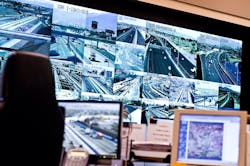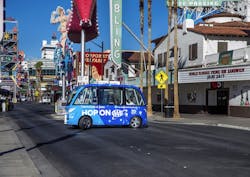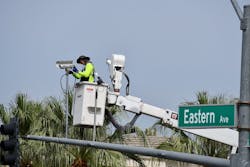By: M.J. Maynard
As transportation technologies advance, the limits appear boundless.
Connected and autonomous vehicles continue to develop at an astounding rate while waiting for both infrastructure and public policy to catch up. These advanced technologies and platforms require seamless communication with traffic signals and related devices when operating, as they often cross multiple jurisdictional boundaries in one trip. In Southern Nevada, home to the greater Las Vegas metropolitan region, it is our priority to provide connected, coordinated, and intelligent traffic management services that are mission critical to the future of transportation, including connected and autonomous vehicles.
The Regional Transportation Commission of Southern Nevada (RTC), along with the Nevada Department of Transportation and Nevada Highway Patrol, operates the region’s state-of-the-art traffic management center, one of the nation’s first truly integrated traffic management centers utilizing a myriad of intelligent transportation system (ITS) technologies to monitor and control traffic across all jurisdictions.
In recent years, Southern Nevada’s integrated and collaborative traffic management partnership has enabled the region to be a leader in testing and implementing groundbreaking technologies that will shape the future of transportation on a global scale. Private companies can work with just one regional entity versus multiple—sometimes even more than 100—individual agencies and jurisdictions in other communities. As a result, Southern Nevada is the region of choice for many innovative companies seeking to test new technologies that can improve traffic flow and safety.
These pilot projects and emerging technologies also allow Southern Nevada to test solutions that aim to connect people to services; improve safety, reduce congestion, and increase capacity; and develop smarter, data-driven solutions.
Connecting people to services
One of the areas of foremost importance to the RTC is connecting people to services. ITS connectivity to traffic signals is a critical component for the development of autonomous vehicles, which Nevada embraced by being the first state in the nation to establish their legal use on public roads.
The nation’s first fully self-driving shuttle to operate in mixed traffic, which was sponsored by AAA and Keolis, transported more than 32,000 passengers on nearly 5,000 trips in downtown Las Vegas. Building on its success, the RTC and city of Las Vegas are developing an autonomous shuttle project called GoMed that will connect downtown Las Vegas to a growing medical district. Through three self-driving shuttles, GoMed will further enhance our transportation ecosystem with nearly two dozen smart transit shelters, upgraded Wi-Fi, and innovative pedestrian safety technologies, including pedestrian detection software and dynamic signal timing adjustments at intersections.
Our upgraded ITS system is also empowering an autonomous vehicle project by Lyft and Motional that has provided more than 100,000 self-driving rides (averaging two passengers per ride) to over 3,400 destinations across the Las Vegas valley. This pilot is critical to the development of autonomous vehicle technology by building public confidence with self-driving vehicles. In fact, 92% of passengers reported feeling very safe or extremely safe during the ride.
Improving safety, reducing congestion, and increasing capacity
To more efficiently connect people to services, we must also focus on improving safety, reducing congestion, and increasing capacity on our limited roadways. We have seen great results and served as the testing ground for several new technologies because of our regional approach towards advancing traffic management.
One of those technologies is a platform from Waycare, which allows for quicker real-time reporting of traffic crashes or other incidents that enhances safety and reduces congestion. Through the Waycare platform, RTC harnesses the power of crowd-sourcing through apps such as Waze; this two-way communication provides RTC information from drivers in real time on incidents and road conditions, as well as the RTC sharing real-time traffic alerts with Wazers.
During our initial pilot, Waycare technology enabled emergency responders to respond to crashes up to 12 minutes faster, which means clearing incidents more quickly, allowing traffic to flow again, and reducing the chance of secondary crashes. Waycare’s analytics and artificial intelligence technology can also predict where dangerous driving conditions or congestion may occur, helping to reduce primary crashes by 17% along I-15, which runs through the urban core of Las Vegas.
We broadened our partnership with Waycare through additional vehicle telematics data partners to acquire connected vehicle data from up to 60,000 vehicles on daily traffic operations, such as the percentage of vehicles that stop and turn at an intersection as well as the average speed and the length of the vehicle queue. This data will assist in identifying hot-spots that are subject to harsh braking and swerving maneuvers to better inform road safety improvements, real-time traffic operations, and driver alerts for proactive crash prevention. The access to and use of this data is the first of its kind at this scale.
In partnership with the city of Henderson and Clark County, the RTC recently launched an adaptive signal control technology pilot program along a consistently congested corridor in the valley. Instead of using traditionally timed traffic signals, adaptive signal control technology can dynamically adjust signal timing based on actual demand, helping make traffic signals more efficient and potentially resulting in reduced traffic delays and congestion, improved travel time reliability, decreased vehicle emissions, and improved safety. Unlike the traditionally restrictive and somewhat static time-of-day plans, adaptive traffic signals are intended to react to changing traffic conditions caused by special events, road construction, and other roadway incidents to provide the best solutions to traffic signal phasing based in real time.
Developing data-driven solutions
With the millions of data sets we collect, analysis is key to developing data-driven solutions that will help us achieve the goals of connecting people to services and enhancing safety and capacity on our roads. Data and connectivity are pillars of advanced ITS technologies and provide guidance on actionable, real-time traffic management.
Our partnership with INRIX uses a state-of-the-art platform called AV Road Rules to digitize and communicate traffic rules and restrictions—such as speed limits, crosswalks, turn restrictions, and bike lanes—to connected and autonomous vehicles, allowing them to operate safely and effectively. In turn, connected vehicles will communicate through our regional traffic management system to report infrastructure issues, such as potholes, inadequate lane striping, and insufficient signage. The data in this platform will be extremely valuable to automotive manufacturers as they continue to develop the technology for connected and autonomous vehicles.
In closing
While the RTC is involved in numerous programs and pilots to improve the region’s mobility, we are not alone in working toward this goal, as private-sector companies are also pursuing the latest in transportation technology. Virgin Hyperloop, which is testing a high-speed technology that promises to carry passengers up to 600 mph, recently completed the first ride on its Las Vegas test track. And The Boring Company has completed excavation of two underground tunnels connecting the Las Vegas Convention Center campus that will carry passengers through Tesla vehicles.
These achievements are momentous industry firsts that are laying the foundation for the future of transportation efficiency and safety. These pilots demonstrate how a cooperative, state-of-the-art ITS program can serve as a model for the other communities as transportation technology continues to evolve. Through partnerships and a commitment to innovation, we are building a transportation ecosystem that will enable us to be prepared for an autonomous future.
About The Author: Maynard is CEO of the Regional Transportation Commission of Southern Nevada.



